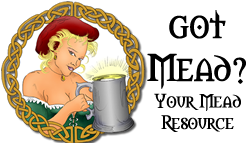Hi all,
I recently began my first batch of mead, and my first ever home brew.
After much research and many hours spent surfing the net, I decided it was time to put my new found knowledge into action.
With all the different recipes and methods of production around, here's what I went with.
MUST:
6.5kg/14.3lbs of white gum honey (white gum is a variety of Australian eucalyptus tree),
4 whole cinnamon sticks,
10 whole cloves,
5 navel oranges (quartered and seeds removed),
Water to make up a total volume of 23L/5 Imperial gal.
STARTER:
100 raisins (blanched with 200ml/6.9oz boiling water, then allowed to cool to room temp before adding yeast),
300ml/10.1oz of room temp must
3 x 5g/0.175oz packet of Lalvin EC-1118 yeast.
PROCESS:
I put about 1/2 of my water into a large boiler and bought it up to 50C/122F, took it off the heat, then added the honey. After all the honey was well mixed, I put it back on the heat. I let it warm for about 15 mins to allow the scum to float, so I could skim it off. After I had removed all the solids (or as much as I could), I added the oranges, cinnamon and cloves; while the must was still hot.
I then splash filled my primary fermenter with the must, to aerate it, and added the remaining volume of cold water to bring it down to pitching temp.
With my starter I poured hot water over the raisins, then crushed them with a potato masher. After letting the raisins cool a bit, I poured in some of my must, pitched in my yeast and let it sit for about 15-20 minutes... The yeast went off, I had a brilliant layer of bubbles on top of the starter and what I assume is a very happy little colony.
I pitched in my starter, gave it a good stir then took my initial gravity reading, SG 1.095 @ 32C/89.6F
After fitting the lid and airlock, in half an hour I had some pretty decent bubbling, about 1 every 20 seconds; in 2 hours it was about once every 5 seconds.
My brew has been alive for 3 days now and all seems to be going well. I took the lid off it this afternoon, and gently ran a wine paddle through it to ensure the yeast was well suspended in the must. I have the same rate of one bubble every five seconds through the airlock and it smells absolutely delicious.
However...
Where I live it is quite hot during the day, for example today was 38C/100F. The coolest room in my house is about 30C/86F, during the middle of the day. Is this too hot for good fermentation with EC-1118? I have read about the production of fusel alcohols and phenols at high fermenting temps, but Lalvin says that EC-1118 will still be quite happy at these higher temps.
I was wondering if anyone has had previous experience with using EC-1118 at higher temperatures and what their results were?
Cheers.
I recently began my first batch of mead, and my first ever home brew.
After much research and many hours spent surfing the net, I decided it was time to put my new found knowledge into action.
With all the different recipes and methods of production around, here's what I went with.
MUST:
6.5kg/14.3lbs of white gum honey (white gum is a variety of Australian eucalyptus tree),
4 whole cinnamon sticks,
10 whole cloves,
5 navel oranges (quartered and seeds removed),
Water to make up a total volume of 23L/5 Imperial gal.
STARTER:
100 raisins (blanched with 200ml/6.9oz boiling water, then allowed to cool to room temp before adding yeast),
300ml/10.1oz of room temp must
3 x 5g/0.175oz packet of Lalvin EC-1118 yeast.
PROCESS:
I put about 1/2 of my water into a large boiler and bought it up to 50C/122F, took it off the heat, then added the honey. After all the honey was well mixed, I put it back on the heat. I let it warm for about 15 mins to allow the scum to float, so I could skim it off. After I had removed all the solids (or as much as I could), I added the oranges, cinnamon and cloves; while the must was still hot.
I then splash filled my primary fermenter with the must, to aerate it, and added the remaining volume of cold water to bring it down to pitching temp.
With my starter I poured hot water over the raisins, then crushed them with a potato masher. After letting the raisins cool a bit, I poured in some of my must, pitched in my yeast and let it sit for about 15-20 minutes... The yeast went off, I had a brilliant layer of bubbles on top of the starter and what I assume is a very happy little colony.
I pitched in my starter, gave it a good stir then took my initial gravity reading, SG 1.095 @ 32C/89.6F
After fitting the lid and airlock, in half an hour I had some pretty decent bubbling, about 1 every 20 seconds; in 2 hours it was about once every 5 seconds.
My brew has been alive for 3 days now and all seems to be going well. I took the lid off it this afternoon, and gently ran a wine paddle through it to ensure the yeast was well suspended in the must. I have the same rate of one bubble every five seconds through the airlock and it smells absolutely delicious.
However...
Where I live it is quite hot during the day, for example today was 38C/100F. The coolest room in my house is about 30C/86F, during the middle of the day. Is this too hot for good fermentation with EC-1118? I have read about the production of fusel alcohols and phenols at high fermenting temps, but Lalvin says that EC-1118 will still be quite happy at these higher temps.
I was wondering if anyone has had previous experience with using EC-1118 at higher temperatures and what their results were?
Cheers.





